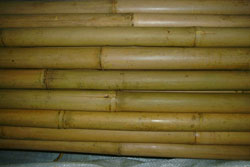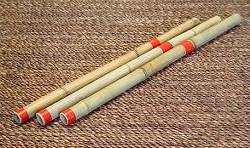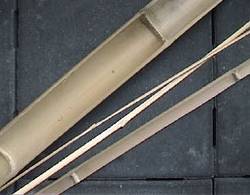In a March 2005 discussion on the unusual or not unusual properties of the sticks described by Roswell incident witnesses, one contributor suggested that the hardness of the stick might explain much better if they were not balsa wood sticks but bamboo sticks:
"I suggested already a few years ago, without that causing any reaction, that the rods used for the radar targets could have been made of bamboo wood rather than of balsa... A material less light than balsa but much more resistant, which could be mistaken for balsa if one does not pay too much attention but to the very strange aspect if one looks at it closely (somehow evoking a composite plastic material), and traditionally very much used for kites (it seems to to me that toy manufacturer which provided the basic materials of the targets radars, among which the famous "flowered scotch tape", had been selected precisely because it manufactured kites). To see for yourself what bamboo wood resembles, buy food rods for Chinese cooking..."
Unfortunately a few years ago I had yet to develop an interest in ufology matters thus I could not have looked into this interesting proposition.
Of course, one may refer to some of the witnesses of the sticks found by William Brazel and remind that they are describing something lightweight like balsa wood but which was not wood. For example, Loretta Proctor told that "The piece he [William Brazel] brought looked like a kind of tan, light brown plastic ... it was very lightweight, like balsa wood. It wasn't a large piece, maybe about four inches long ... We cut on it with a knife and would hold a match on it, and it wouldn't burn. We knew it wasn't wood. It was smooth like plastic;, it didn't have real sharp corners, kind of like a dowel stick. Kind of dark tan. It didn't have any grain ... just smooth." William Brazel told of: "... some woodenlike particles ... like balsa wood in weight, but a bit darker in color and much harder ... It was pliable but wouldn't break ... weighed nothing, but you couldn't scratch it with your fingernail. Some of it was like balsa wood: real light and kind of a neutral colour, more of a tan. To the best of my memory, there wasn't any grain in it. Couldn't break it ... it'd flex a little. I couldn't wittle it with my pocket knife." Floyd Proctor told "He [William Brazel said it wasn't paper because he couldn't cut it with his knife, and the metal was different from anything he had ever seen." And we may counter-argument with witnesses who did refer to wood sticks.
But this is out of scope for now: the sole purpose of the following is to provide evidence, if any, that the sticks from Mogul project's balloons radar target were of balsa wood or bamboo wood.
Again: this article is not about refuting bamboo or balsa or claiming that bamboo or balsa really were among the debris. This is only, assuming that the debris sticks were of wood for the sole purpose of the discussion, to discuss some aspects of the question: "if it was wood, why would it be bamboo and not balsa?"
I have not found one single author, whatever his position may be, who tells of any other wood than balsa for the radar target sticks. For example, John Shirley [1] tells that "The balloons were made - some say - of a shiny metallic material, like mylar. The balsa wood was covered, perhaps to protect it from moisture, by a household shelf-covering material or decorative tape, ..."
Of course it is apparent that most authors do not specify how they know it was balsa wood. Quite simply, they were told so by Professor C.B. Moore, the man who launched the trains of balloons in project Mogul's tests.
According to Robert A. Galganski, a ground vehicle crash safety systems research and development specialist, [2] C.B. Moore told in a personal correspondence dated March 31, 1995, that "These targets consisted of nine right-triangular segments with 24-inch-long bases and heights. Each segment consisted of a panel of aluminum foil laminated to some fairly tough, heavy-duty paper and deployed on balsa wood struts."
The same author indicates [3] another statement by C.B. Moore in an October 31, 1994, People magazine. In an article titled "A Saucer Scorned," Moore told that "the balsa wood was soaked in glue ..." and it made the wood "a little bit stiffer and less easy to dent than ordinary balsa."
(Galganski adds that Moore is also on record saying that the struts were coated with glue to stiffen and render them non-combustible but hat is out of the scope of this paper.)
In an article by Dave Thomas, a physics and mathematics graduate of New Mexico Institute of Mining and Technology, and vice president and communications officer of New Mexicans for Science and Reason, Moore's own words to him in 1995 were "When the wind information is coupled with the similarities in the debris described by the eyewitnesses - the balsa sticks, ..."
In the Roswell section of my website [4] I provide the drawings by C.B. Moore which are his 1992 recollections of the sticks. Again, the caption indicates: balsa wood.
1st Lt James McAndrew of the US Air Force, who participated in the Air Force's findings on project Mogul, and whose article is a key portion of the 1995 Air Force publication, provided the description of the radar target as "A radar target was a multisided object, which, in appearance, resembles a box kite constructed of balsa wood and ..."
However he also adds:
"According to the sole living participant in the recovery, Sheridan Cavitt, he, Major Marcel, and MSgt William Rickett gathered some of the material, which appeared to resemble 'bamboo type square sticks, one quarter to one half inch square,' that was 'very light'..."
Sheridan Cavitt was the head of the Army Counter-Intelligence Corp at Roswell Army Air Force Base.
So we have one witness mentioning bamboo. According to Col. Weaver, USAF investigator, Sheridan Cavitt told him in 1994 [8]:
"We [Lewis Rickett and Cavitt] went out to this site. There went out there and we found it. It was a small amount of, as I recall, bamboo sticks ..." and "We gathered up some of it and took it back to the base and I remember I had turned it over to Marcel."
However there are many problems with Sheridan Cavitt's recollections.
A first problem is that when he was identified as witness by Loren Gross in 1980, he refused to be interviewed on the ground that he never was stationed in Roswell at all. Then, he told he was a CIC officer at Roswell at that time but refused interviews because he never went to the site. Later, in 1990, after Lewis Rickett signed an affidavit in which he swore that he was on the site with Cavitt, and researchers found more documented evidence that Cavitt was indeed the head of CIC at Roswell, the latter finally acknowledged that he had been on the site with Rickett but said he can't remember that Jesse Marcel was there. But he acknowledged that only to col. Weaver, while at the same time continuing to refuse interviews to ufologists on the ground that he never went to the debris site and was "not involved" at all. In the statements to USAF investigators reproduced in their 1994 report, he remembers to have been on the site, but with Lewis Rickett, not Jesse Marcel: he tells he brought the debris back to Marcel who had stayed at the army air base. When asked about the flowered scotch tape by Weaver, he said he can't remember anything like that. Unlike Marcel, Tyree, Rickett, Exon, Adair, he told that there were no gouge at the site. He also claimed in a signed statement to the Air Force that he went to the site with Rickett and Marcel, but they went on their own, and never met William Brazel, which does not make sense simply because they could not have located the site without Brazel. In contradiction to the statement by Rickett, Cavitt told Weaver that he didn't go to the site a second time. He his also the only witness who said the debris area was only a tiny 20 foot square area. While Marcel and his wife Viaud Marcel told that they knew Cavitt, that logically enough, as an Intelligence colleague of Marcel, he sometimes came over for a cup of tea, he told he remembers no such thing. He said that when he went to the debris field, he immediately recognized the debris as a weather balloon; however, he fails to mention any radar target, and he is the only one mentionning a black box; furthermore, one can wonder why he did not tell Marcel of Blanchard that the debris were of a balloon if he knew that from the start.
(Many other statements in Cavitt's sworn statement to the USAF in 1994 may be of interest:
"I do not recall attempting to burn any of this debris but my wife tells me she recalled that Jesse Marcel, his wife and son did have a small piece that they held over the fire when we had a cookout."
In the discussion, the contributor suggested that although the radar targets' stick were usually made of balsa wood, in this particular case indeed, they may have been made of bamboo wood: after all, he proposed, the radar targets were exceptionally made by a toy manufacturer, and since they did not use the standard scotch tape, they may also have used an unusual wood. He also pointed at the indications that these particular radar targets were a bit wider than the usual and thus it is logic that a stronger wood than balsa had to be used.
What do we know of the origin of the radar targets used in the Mogul project? According to Colonel Trakowski, chief of project Mogul, it was Major Jack Peterson who was in charge of the procurement of the radar targets. Trakowski told the 1995 USAF interviewer [7]:
"Jack monitored the procurement of these radar targets, and I believe Ed Istvan either worked for or alongside Jack Peterson, and I remember when they finally... Now this was all not under my purview, but I worked in the same building with them, and I knew Jack very well, he was a very good friend and we talked and joked with each other a lot. I remember so clearly when the contractor for these targets was selected, and Jack thought it was the biggest joke in the world that they had to go to a toy manufacturer to make these radar targets. Then it was even a bigger joke when it turned out that because of wartime scarcities of materials, the tape that they used to assemble these targets, the reflecting material on the balsa frames, was some kind of a pinkish purple tape with a heart and flower design on it. This was, again, a big flap."
So again, at the manufacturing level, balsa wood sticks were used to build the frames, according to everyone's recollections.
(Moore did not know why tape with colored flowers was used. According to Philipp Klass, he told investigator Robert Todd that some of the radar targets produced during World War II had been made in Manhattan lofts used to manufacture women's garments.)

|
Botanically speaking, bamboo is not a tree but grass. Its qualities are that its dimensions remain stable, and it is very hard.

|
This is a wall made of Tonkin bamboo. Each piece has four to ten centimeters diameter. The bamboo is carbonized to become very hard.

|
Bamboo sticks.

|
How to get squared bamboo sticks of various dimensions.
There is a good reason why balsa wood had to be used. Balsa wood is a lightweight wood, and the target had to be lightweight. If the weight gains were unimportant, any other wood would have been used, because balsa wood is very, very, fragile. If the overweight of bamboo wood had not be too much of a weight problem, balsa wood would probably never have been used.
However, it can be counter-argumented that, although bamboo would be heavier than balsa, it is stronger, and thus it it the same in the end because a less important volume of bamboo would be as strong or stronger than balsa.
I have been unable to calculate the diameter that bamboo sticks would have given a certain volume of the required bamboo to provide the expected strength, but this calculation may be interesting: it is possible that the diameter or width and depth of bamboo sticks would then be much thinner than the debris sticks as described by the Roswell incident witnesses of the debris field in 1947.
I do not offer a conclusion for now, as the topic is still under discussion/research.
Patrick Gross - March 2005.